The Sky This Month Feb-Mar 2015
March is the best month to try the Messier Marathon. We start the month off with a Lunar X opportunity. Later this week one might see the "Handle of Moon" and the naked-eye occultation of lambda Geminorium. The Moon will join Saturn and Antares in the morning of Mar 13 for a vista similar to the early-Feb Moon-Venus-Mars grouping. Around the new Moon of Mar 20, you might, from a dark sky location see zodiacal light and Gegenschein. We even have a day-time Venus opportunity. And we will continue to enjoy Jupiter “events” like transits, shadow transits, occultations, and eclipses. Assuming the clouds go away.
Blake Nancarrow delivered the following The Sky This Month presentation at the 25 February 2015 Recreational Astronomy Night Meeting at the Ontario Science Centre. The handout provided included a calendar for portions of Feb and Mar 2015. You may view or download and print the colour calendar PDF file (440 KB).
All photos copyright the respective owners. The top image is a "Planetary Face-off" with Jupiter rising in the east and Venus setting in the west. Feb 2015. Copyright © 2015 Stu McNair. Used with permission.
The Sun
The Sun is above those clouds. No. Really. It is... Don’t believe me, then.
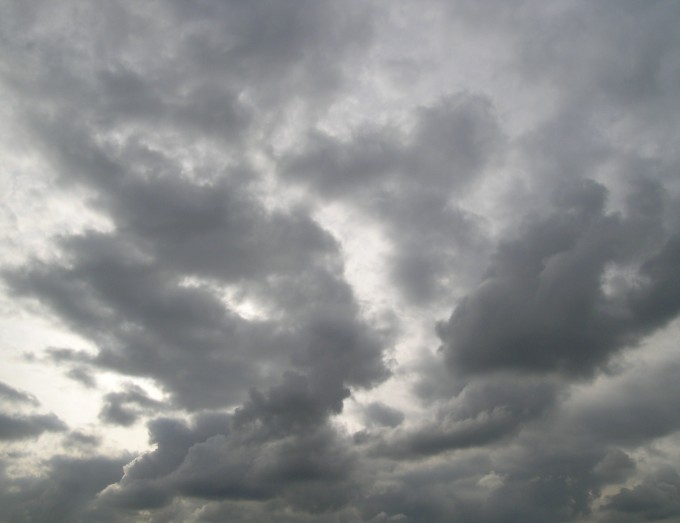
The Sun is purportedly in Aquarius, if you care. It moves into Pisces on Thursday 12 March. In case you’ve been looking for it, the last planet in the solar system, Neptune is hidden behind Sol. The Sun will be in a solar “occultation” (otherwise known as a solar eclipse) on 20 Mar but you’ll need to be on a boat in the north Atlantic to enjoy it.
Luna
Today (at the time this presentation was delivered), 25 February, the Moon is in first quarter phase. On 5 Mar the Moon will be full while, at the same time, the smallest Moon of 2015. I don’t hear the media hyping the... anti super Moon... or the super anti Moon. What ever. On Friday 13 Mar we have lucky 3rd quarter. And, once again, on 20 Mar, we have the new Moon phase, which is helping block the Sun.
That will also kick off a dark sky weekend in March, one which some circle on their calendar, so to participate in The Marathon. More on that later...
Also, 20 Mar will be the equinox, the day with equal light and dark periods.
Possibly on the evening of 20 Mar, at dusk, you might be able to see a very young, paper thin, Moon!
25 Feb was the first of four possible Lunar X opportunities in 2015. When the Sun is at a very oblique angle to the craters Blanchinus, La Caille, and Purbach, during first quarter, the tall crater walls appear to form a letter X from our vantage. This apparition is the best of the year with the Moon being very high in the sky; the next opportunity is on Sunday 26 April at 1:19 AM EDT. But then, the Moon’s elevation will be 12 degrees!
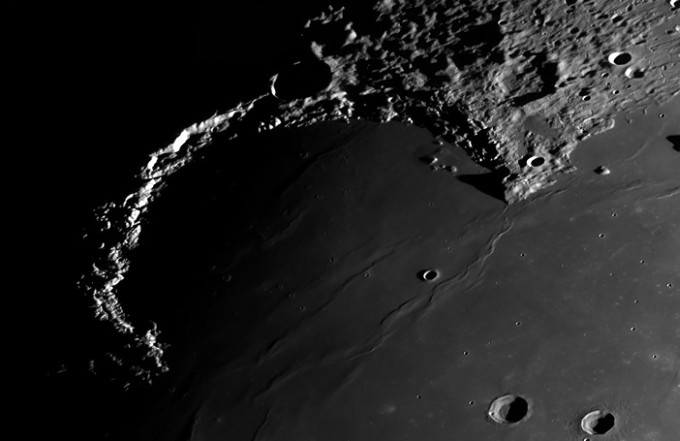
Sinus Iridum from 2 Feb 2012. Celestron C14 XLT with a DMK 41 AU02. Copyright © 2012 Mario Weigand. Used with permission.
There are a number of other interesting lighting features on the Moon including “The Handle.” On Sat 28 Feb, look in the area of the Jura Mountains and Sinus Iridium in the north-east region. When the sunlight comes from the east, the lava-filled crater is intriguing -- it is missing the western walls. But when the sunlight comes from the west at a low angle, the east range of the crater remains in darkness while the tall crater cliffs are brightly illuminated. This gives the appearance of a C-shape, an arcing line that looks like the handle of a coffee mug.
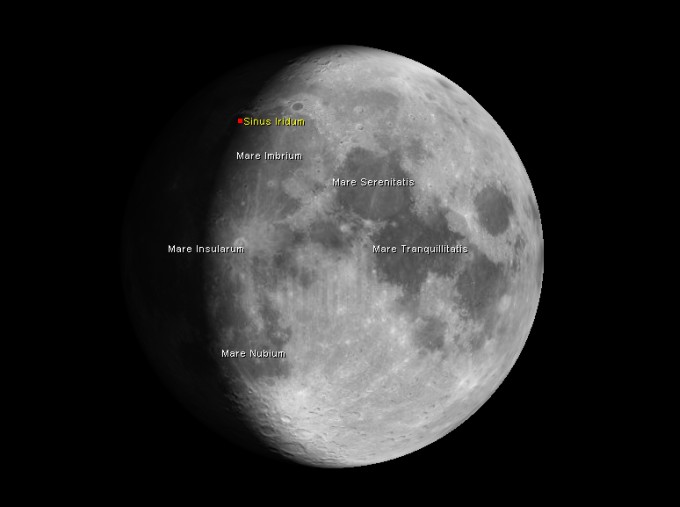
Sinis Iridum is location in the north-east region of the Moon. Image from Virtural Moon Atlas.
Also during this same evening the Moon will occult lambda Geminorum. The bright naked-eye star will be blocked first on the dark side of the Moon, at 7:46 PM EST, to re-emerge at 9:09 PM, on the bright side. Note that this is a double star so you may observe it dim or brighten in a step fashion and possibly change colour.
gatherings
I hope you had an opportunity to see the wonderful grouping of Venus, Mars, and the Moon last weekend (early February). I saw many photographs by our members and other amateur astronomers.
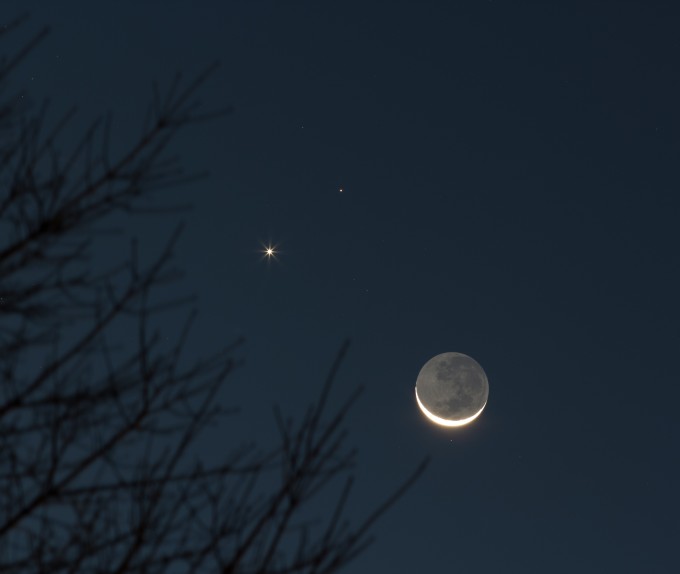
Beautiful photo from their Mississauga backyard, Feb 2014. Copyright © 2014 Elaine and Tony dos Santos. Used with permission. Canon 60D, 12 seconds, f/6.3, 200mm, ISO 100, Lightroom.
There will be another chance to see a similar vista on Mar 21 and 22. Venus will not be as close to Mars then but still the Moon will pass by the two planets over two evenings. In fact, both Venus and Mars are rising up in the sky, Venus very fast, closing in on Uranus. Mars, curiously, rises at a rate matching the sideral (or background star) rate. Effectively, it will hold steady in the western sky for the entire month. Mind you it is drawing away from us the whole time so slowly getting fainter.
Yet another similar vista may occur on the morning of Fri 13 Mar when the Moon will join beige Saturn and ruddy Antares. Early riser photo op!
There’s a safe day-time opportunity to view Venus in a day-lit blue sky. On Sun 22 Mar use your binoculars to find the young Moon and scan nearby for a brilliant but tiny point of light. Take away the binoculars and see if you can spot Venus with your naked eye.
Jupiter high
The King of the planets is high up in the sky in our evenings.
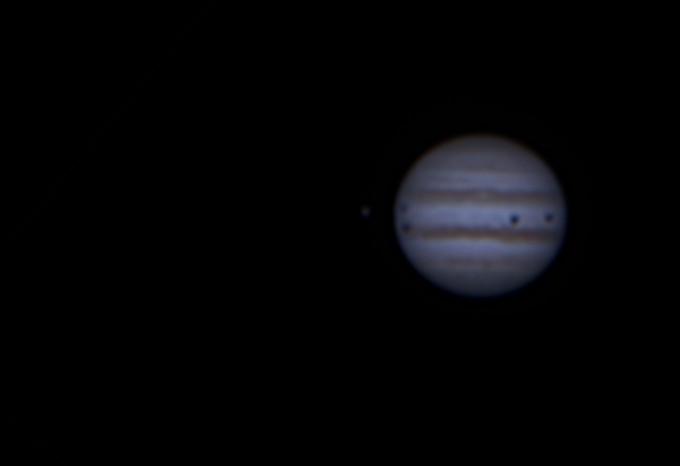
Triple shadow transit. Copyright © 2015 Tony dos Santos and Blake Nancarrow. Celestron 11. One-shot Point Grey colour camera. FlyCap, Registax 6, and Photoshop CS2.
Jupiter will continue to delight this month. There are many interesting events occurring with many happening simultaneously, such as transits of the Great Red Spot (GRS), shadow transits, moon transit, occultation and eclipses by either the planet or another moon. I noted these on my calendar simply as “Jupiter events.” Two or more things are happening at the same time.
By the way, if you’re comfortable editing text “initialization” files for software, you might update the rotation value in Stellarium to between 80 and 90 to reposition the Great Red Spot in a location that is close to reality. Don’t forget to enable light speed simulation in the software as well when comparing your view in the eyepiece.
small but fascinating
Ceres was the first “asteroid” discovered and is numbered accordingly. It is now referred to as a minor planet.
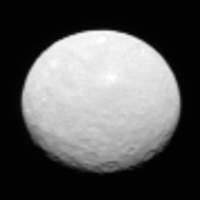
The NASA DAWN space probe is closing in on (1) Ceres. It will feel the effect of Ceres's gravity on Fri 6 Mar. It will be exciting for us watching the image quality and colour improve.
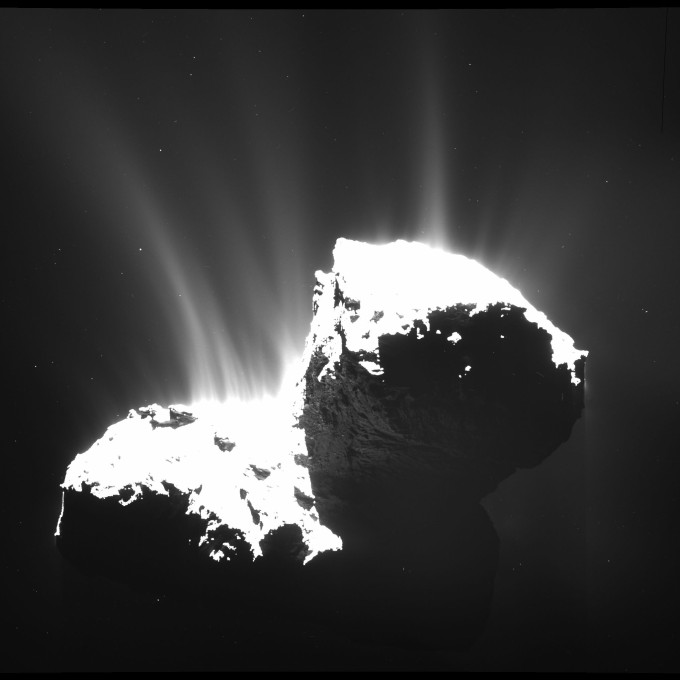
It is fascinating watching the European Space Agency probe Rosetta dive-bomb comet 67P/Churyumov-Gerasimenko. The closest recent flyby was at 6 km! Still no peep from the Philae lander...
Of course, comet C/2014 Q2 has put on a spectacular show and I saw, again, many wonderful images captured.
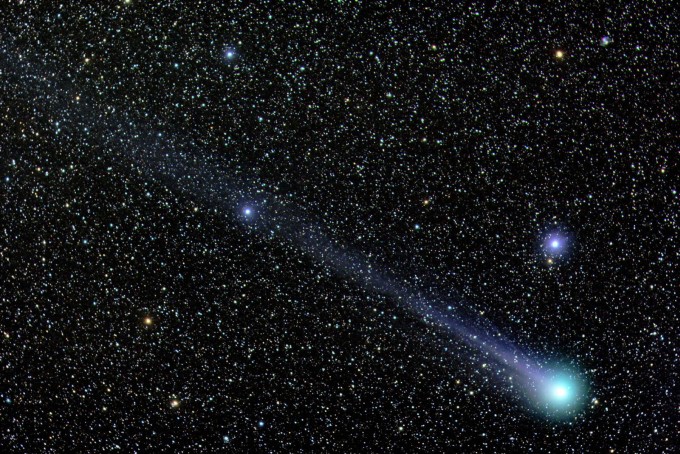
Comet C/2014 near Messier 76. Copyright © 2015 Ernő Berkó. Used with permission. 80/600 refractor with flattener, Canon 350D, ISO 1600.
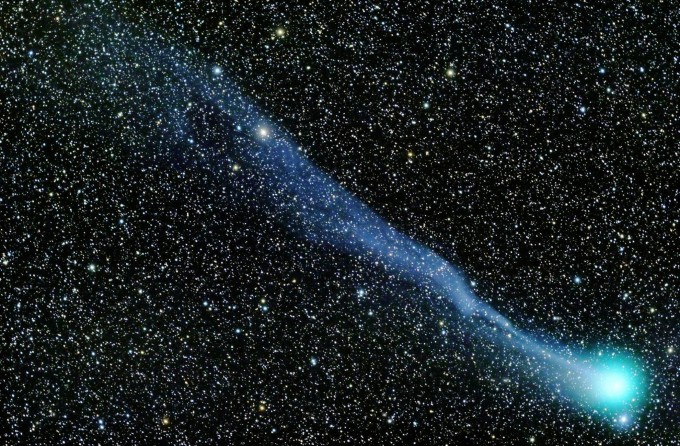
Comet C/2014 tail. Copyright © 2015 Ernő Berkó. Used with permission. 80/600 refractor with flattener, Canon 350D, ISO 1600.
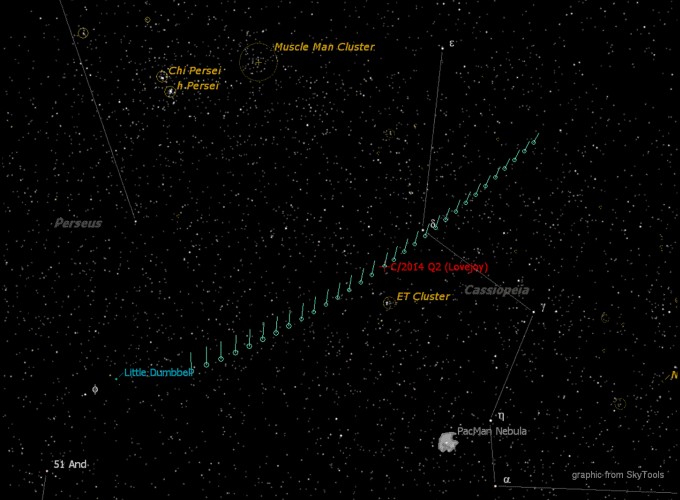
There’s still opportunities to view this comet even though it is moving away from the Sun. It is travelling through Cassiopeia this month. It will pass close to the ET Cluster (aka NGC 457) and then very close to delta Cas (aka Ruchbah). It is around magnitude 6 now but dimming and the tail is getting shorter.
Another comet to try for is 15P/Finlay. It is visible in the evening with a small telescopes. It is in Pisces and moving into Aries. It will be around magnitude 10 to 11.
multi-stars
There are many attractive double and multiple stars but many do not know of them... Put on the parka and check 'em out!
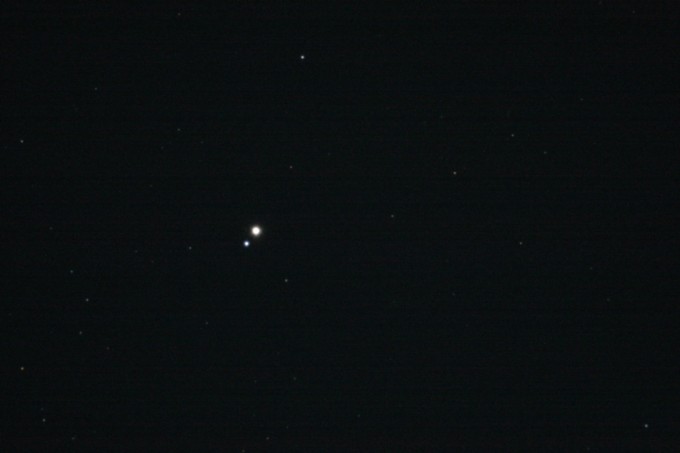
HR 6983 in Draco. Copyright © 2014 Blake Nancarrow. Celestron 14, f/11, unguided, Canon 40D, 15 seconds, ISO 400, daylight white balance.
26 Auriqae is a colourful pair, with a yellow-gold or orange primary and a faint blue companion. 11-12 Camelopardalis is fantastic with a bright blue-white main star and a companion that is a deep orange. Σ1327 aka HD 79552 is coloured. I thought them yellow and orange or red; the RASC Observer’s Handbook says yellow and blue. My favourite winter double is HR 2764 in Canis Major aka The Winter Albireo. The main star is orangey and the partner blue. A wonderful sight but a bit off the beaten track. Σ1149 CMi aka HD 63536 seem yellow and blue to me. Sissy Haas says “grapefruit-orange and silvery-yellow.” γ Leporis
is yellow and orange. 5 Lyncis is a lovely colourful possibly with an aquamarine or greenish star! 15 Monocerotis, in NGC 2264, is actually a multi-star system. Haas notes 5 stars; SkyTools says there are 21!
For some challenge double stars, assuming you have an excellent southern horizon, try for colourful HR 2316 in Columba and then head over to alpha Pyxidis. Did you know Pyxis is completely above, this time of year, the horizon for us in Ontario?
This time of year is excellent for planetary nebulae. A few easy candidates are the Cat's Eye in Draco, the Turtle Nebula in Hercules, the apropos Eskimo Nebula in Gemini, the Blue Racquetball in Ophiuchus, and the Ghost of Jupiter in Hydrae.
There are also lots of open clusters to take in like Messier 36, 37, and 38 in Auriga. Who can forget the incredible Pleiades. The Moon will be near the Hyades on March 24.
pop
There’s a supernova to try for with your 8” or larger telescope.
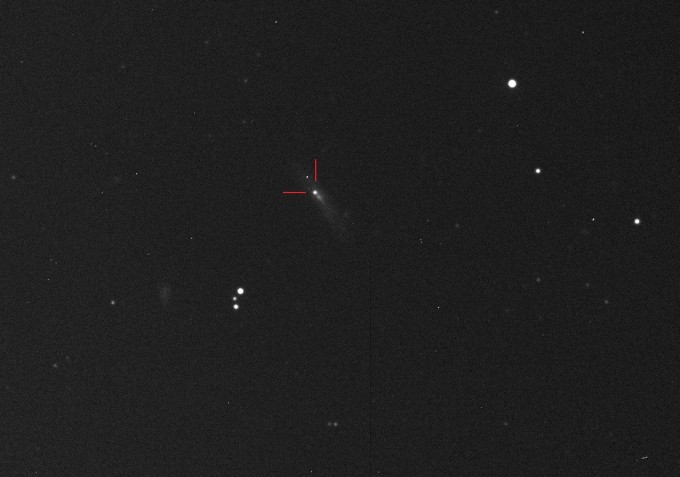
Supernova image. Copyright © 2012 Andy Cason. Used with permission from David Bishop. Visit the current supernovae page.
The type 1a supernova ASASSN-14lp is around magnitude 13.7. It is in the galaxy NGC 4666 which is in Virgo, not far from Porrima.
the run
Early I mentioned that March is popular for trying The Marathon, the Messier Marathon. This time of year is ideal if you want to see all the objects from Charles Messier’s famous catalog in one evening! However, you need to use the right order or sequence, starting with M 77 and finishing with M 30.
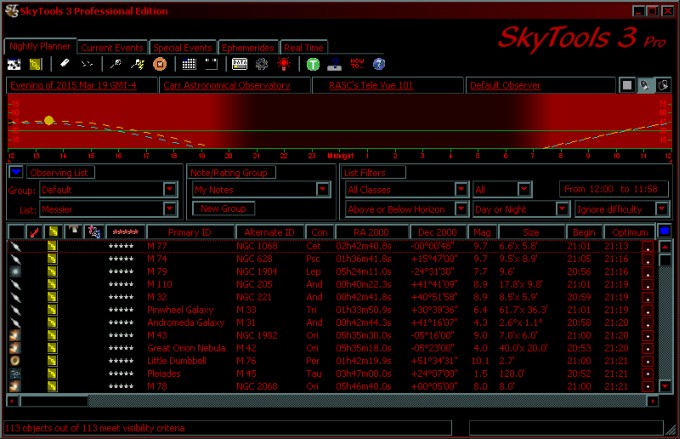
Planning software like SkyTools or AstroPlanner can help. Lists abound on the internet. Let us know how you faire!
recap
To review, your highlights for Feb-Mar 2015 are:
25 – Lunar X
28 – Handle on Moon
– lambda Gem occultation
13 – Moon, Saturn, Antares (am)
20 – new Moon
– very young Moon?
– start marathon?
– zodiacal light and Gegenschein
21 – Moon near Venus
22 – day-time Venus
24 – Moon in Hyades
and Jupiter “events” galore!
Don't forget the switch to Daylight Saving Time. Adjust your observing calendar accordingly.
Be seeing you. Contact Blake Nancarrow astronomy at computer-ease dot com for errors, omissions, questions.

